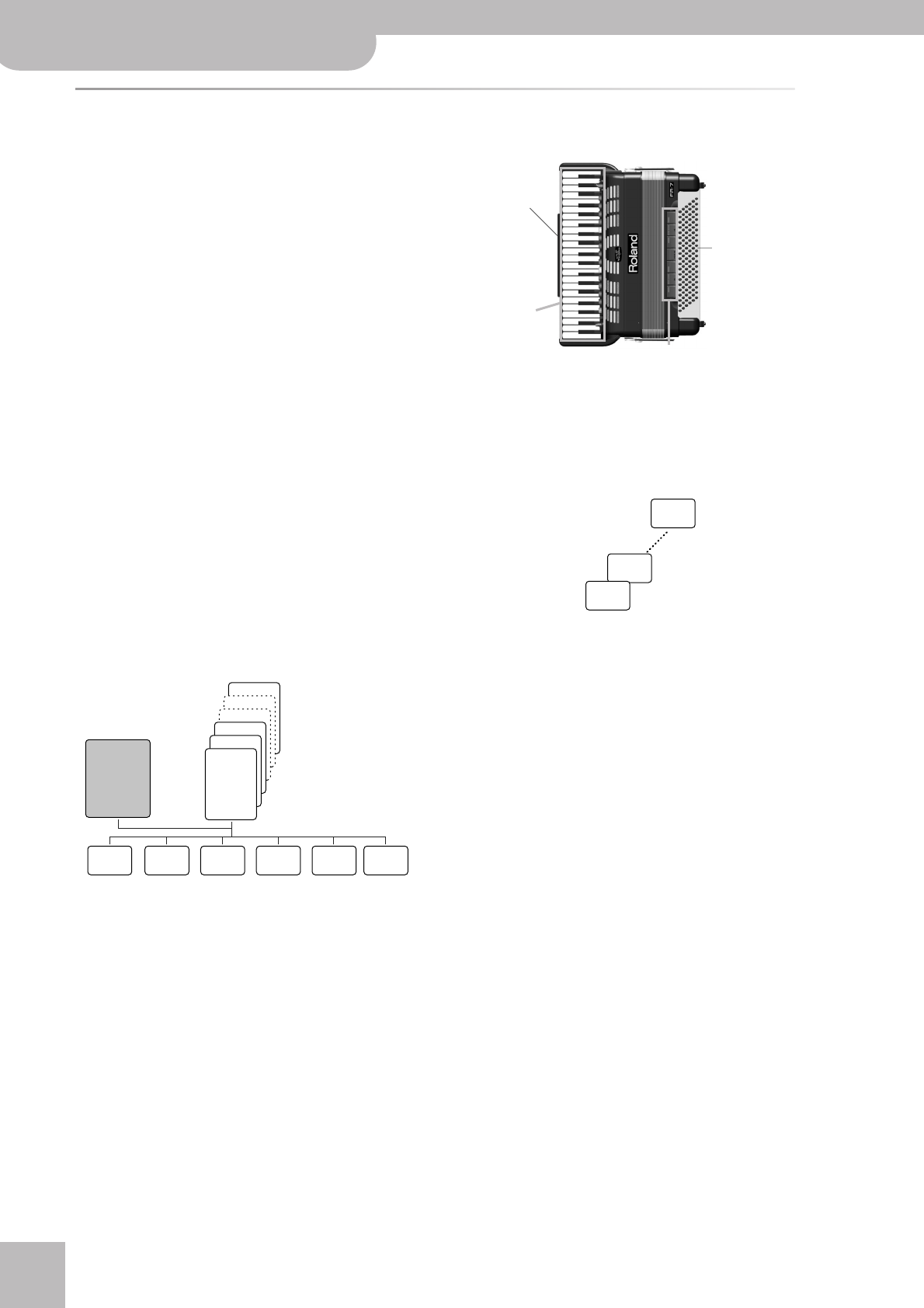
Setting up | First steps
18
r
FR-7/FR-5 V-Accordion
First steps
The sections of your FR-7/FR-5
Before showing you how to use the FR-7/FR-5, let’s briefly look at
the various “sections” of your instrument, as that will help you
understand how your V-Accordion works.
The FR-7/FR-5 is a “virtual” accordion. That term was borrowed
from synthesizers that recreate the sounds of other synthesizers
using a different technology (hence the term “virtual analog syn-
thesizer”, for example).
The FR-7/FR-5 recreates the sounds of various accordion instru-
ments (the “virtual” part) and can even generate orchestral sounds,
like trumpet, flute, etc. (the synthesizer part).
The sections outlined in the illustration to the right contain several
functions you can set. Let us agree to call those functions “parame-
ters”.
The parameters allow you to change certain aspects of
the FR-7/FR-5’s sound: you can select a French
musette, an Italian accordion, etc., specify how strongly
the virtual reeds should be detuned, add digital effects
and more. Each section has its own parameters, so that
you can fine-tune your sounds until you really like the
entire accordion sound. You can save your settings and
select them each time you want to play a given piece.
There is thus no need to set the parameters time and
again.
The various sections are combined into “Sets”. Why
is that? Because that way, you only need to select one
memory (the Set) in order to save and recall the set-
tings of all sections.
There are 40 Set memories that already contain useful
settings right out of the box. But you can replace them
with your own settings. (And if 40 Sets are not enough,
you can archive and load new sets via MIDI, see
page 89).
Sets are like the trunk of a car that contains several
instruments (bandoneon, musette, etc.). The instru-
ments themselves can be recalled via the registers.
There are 14 Treble memories, 7 Bass, Free Bass, Orches-
tra Chord, Orchestra Free Bass, and Orchestra Bass reg-
isters, and 22 Orchestra registers per Set. Except for the
orchestral sounds, the registers can behave like on an
acoustic accordion, i.e. they allow you to change the
footage combinations.
If you are really into programming, however, you could
also assign completely different instruments to each
register, in which case a Set becomes a container (the
aforesaid car trunk) for a variety of accordion sounds.
Another advantage of the Set structure is that it allows
you to reconfigure the three digital effects processors
(Reverb, Chorus, Delay) whose settings always apply to
all sections.
Oh and… the Sets can be selected with the SET [√][®]
buttons on the FR-7/FR-5 and the SET ([1], [2]) foot-
switches on the FBC-7 (if it is connected to the FR-7/
FR-5).
Master bar
Registers of the bass, chord and orches-
tral bass/chord sections
Treble section
Bass,
Orchestra Bass,
Orchestra Chord,
Free Bass,
Orchestra Free
Bass section
Set 40
Set 3
Set 2
Set 1
Treble
1~14
Orchestral
1~22
Bass
1~7
Free Bass
1~7
Orch. Chord
1~7
Orch. Bass
1~7
COMMON
Reverb
Chorus
Delay
Name
Icon
Master Bar
Treble 2:
Italian
Treble 14:
Cajun
Treble 1:
Bandoneon
One possibility: each Treble reg-
ister represents a different
instrument.
The same system also applies
to the Bass, Free Bass, Orches-
tra Bass, Orchestra Free Bass,
Orchestra Chord, and Orches-
tra section.


















